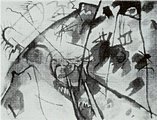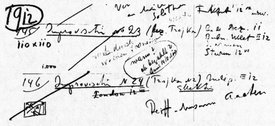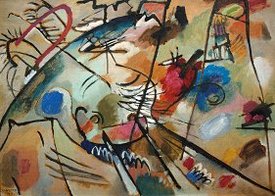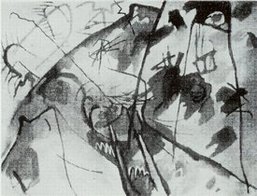The painting is regarded as lost since 1925, at the latest since 1933.
Fortunately, Kandinsky noted the Reiff-Museum down as the new proprietor of his abstract early work from 1912 in his own catalogue raisonné. Otherwise, we would not have any information about Schmid-Burgk’s purchase.
The Reiff-Museum as a guest of the Suermondt-Ludwig-Museum
Thanks to the productive cooperation between the Suermondt-Ludwig-Museum and the RWTH-Aachen (Rheinisch-Westfälische Technische Hochschule) the Reiff-Museum – as a part of the Institute for History of Art – contributes to the exhibition Phantom Gallery. It represents another aspect of the manifold and dynamic culture of collecting in the city of Aachen.
A „museum without objects has an inestimable scarcity value”– Hans Holländer wrote ironically some years ago referring to the sorrowful history of deprivation of the Reiff-Museum at the Technical University of Aachen (RWTH).
Several factors caused a heavy decimation of the collection: Allegedly, it was too conservative in its beginnings, too progressive in its heyday, and later not representative enough. Finally it seemed too heavily loaded with its history of deprivation. Consequently, paintings were early interchanged, sold, and even inadmissibly given away, stolen or sourced out and stored in dark basements. A disdainful evidence reveals the misery: Only 40 paintings of approximately 200 collected by Franz Reiff (1835-1902) are remained, and only two of two dozens of sculptures. The modernity collected by Max Schmid-Burgk (1860-1925) is lost completely. Just as the stock including photographs, that was applied in the 50’s.
Nevertheless the Reiff-Museum is still alive, with increasing pulsation and a growing profile – not least due to the reconstruction of the history of the collection, which always accommodates for the losses.
An example:
From the beginning Max Schmid-Burgk pursued, with his unmistakable grasp for contemporary positions, the goal to establish the avant-garde in Aachen through purchases and temporary exhibitions. Between 1909-25 artists like Klinger, Slevogt, Klee, Macke, Schmidt-Rottluff, Pechstein, Corinth, Erler, Bolz und Kandinsky were exposed, just to name the most important ones. Worth mentioning is the fact that Schmidt-Burgk effected the option on two works of the leading representative of the modernity coming from Munich – Wassily Kandinsky. “Fresh progressiveness” was bestowed on him by extensive donations, which finally allowed him to purchase Kandinsky’s ‘Improvisation 24’ (Troika II) for the Reiff-Museum.


Furthermore, the agile correspondence between the artist, Gabriele Münter and art-dealer Herwarth Walden gives hints that Kandinsky was advised even earlier of the possibilities of exhibiting at the museum of the university by an international working art-dealer. Probably, Kandinsky himself made contact to Schmid-Burgk and his assistant Walter Schürmeyer, which was prolific for both sides. Besides an exhibition together with Hanns Bolz in Nov.-Dec. 1913, Kandinsky noted down short time later: “I sold two paintings to the Reiff museum: Improv. 24 and Blue Mountain. Purchases from museums are important.” Once more the progressive direction of the museum becomes apparent.
Criticism grew louder only short time later, but Schmid-Burgk defended the incunabulum of modernity until his death in 1925. Subsequently, conservative positions prevailed and the department of modernity was closed not later than 1933.


The painting “Improvisation 24” (Troika II) was ultimately published unsatisfactorily in a catalogue composed by Kandinsky in 1918. In order to demonstrate the qualities and outlines of the lost painting as well as the gradual development to abstraction, a “study of Improvisation 24”, which is situated in private ownership, will be displayed next to a picture of the lost painting.
Martina Dlugaiczyk
(Staff Member of the Department of Art History, Rwth Aachen)
Translation: Jenny Jansen
http://www.reiff-museum.rwth-aachen.de


